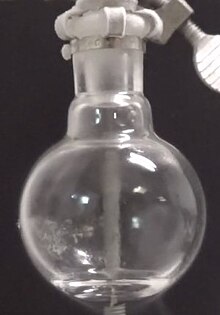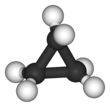Cyclopropane
| |||
| |||

| |||
| Names | |||
|---|---|---|---|
| Preferred IUPAC name
Cyclopropane[2] | |||
| Identifiers | |||
3D model (JSmol)
|
|||
| ChEBI | |||
| ChEMBL | |||
| ChemSpider | |||
| ECHA InfoCard | 100.000.771 | ||
| KEGG | |||
PubChemCID
|
|||
| UNII | |||
| UN number | 1027 | ||
CompTox Dashboard(EPA)
|
|||
| |||
| |||
| Properties | |||
| C3H6 | |||
| Molar mass | 42.08 g/mol | ||
| Appearance | Colorless gas | ||
| Odor | Sweet, ethereal | ||
| Density | 1.879 g/L (1 atm, 0 °C) 680 g/L (liquid) | ||
| Melting point | −128 °C (−198 °F; 145 K) | ||
| Boiling point | −32.9 °C (−27.2 °F; 240.2 K) | ||
| 502 mg/L | |||
| Vapor pressure | 640 kPa (20 °C) 1350 kPa (50 °C) | ||
| Acidity(pKa) | ~46 | ||
| -39.9·10−6cm3/mol | |||
| Hazards | |||
| Occupational safety and health(OHS/OSH): | |||
Main hazards
|
Highly flammable Asphyxiant | ||
| GHSlabelling: | |||
 
| |||
| Danger | |||
| NFPA 704(fire diamond) | |||
| 495 °C (923 °F; 768 K) | |||
| Explosive limits | 2.4 % (lower) 10.4 % (upper) | ||
| Safety data sheet(SDS) | Air Liquide | ||
Except where otherwise noted, data are given for materials in theirstandard state(at 25 °C [77 °F], 100 kPa).
| |||
Cyclopropaneis thecycloalkanewith the molecular formula (CH2)3,consisting of threemethylene groups(CH2) linked to each other to form a triangular ring. The small size of the ring creates substantialring strainin the structure. Cyclopropane itself is mainly of theoretical interest but many of its derivatives -cyclopropanes- are of commercial or biological significance.[3]
Cyclopropane was used as a clinicalinhalational anestheticfrom the 1930s through the 1980s. The substance's high flammability poses a risk of fire and explosions in operating rooms due to its tendency to accumulate in confined spaces, as its density is higher than that of air.
History
[edit]Cyclopropane was discovered in 1881 byAugust Freund,who also proposed the correct structure for the substance in his first paper.[4]Freund treated1,3-dibromopropanewithsodium,causing an intramolecularWurtz reactionleading directly to cyclopropane.[5]The yield of the reaction was improved by Gustavson in 1887 with the use ofzincinstead of sodium.[6]Cyclopropane had no commercial application until Henderson and Lucas discovered its anaesthetic properties in 1929;[7]industrial production had begun by 1936.[8]In modern anaesthetic practice, it has been superseded by other agents.
Anaesthesia
[edit]Cyclopropane was introduced into clinical use by the American anaesthetistRalph Waterswho used a closed system with carbon dioxide absorption to conserve this then-costly agent. Cyclopropane is a relatively potent, non-irritating and sweet smelling agent with aminimum alveolar concentrationof 17.5%[9]and ablood/gas partition coefficientof 0.55. This meant induction of anaesthesia by inhalation of cyclopropane and oxygen was rapid and not unpleasant. However at the conclusion of prolonged anaesthesia patients could suffer a sudden decrease in blood pressure, potentially leading tocardiac dysrhythmia:a reaction known as "cyclopropane shock".[10]For this reason, as well as its high cost and its explosive nature,[11]it was latterly used only for the induction of anaesthesia, and has not been available for clinical use since the mid-1980s. Cylinders and flow meters were colored orange.
Pharmacology
[edit]Cyclopropane is inactive at theGABAAandglycine receptors,and instead acts as anNMDA receptor antagonist.[12][13]It also inhibits theAMPA receptorandnicotinic acetylcholine receptors,and activates certainK2Pchannels.[12][13][14]
Structure and bonding
[edit]
The triangular structure of cyclopropane requires thebond anglesbetween carbon-carbon covalent bonds to be 60°. The molecule has D3hmolecular symmetry.The C-C distances are 151pmversus 153-155 pm.[15][16]
Despite their shortness, the C-C bonds in cyclopropane are weakened by 34 kcal/mol vs ordinary C-C bonds. In addition to ring strain, the molecule also has torsional strain due to theeclipsed conformationof its hydrogen atoms. The C-H bonds in cyclopropane are stronger than ordinary C-H bonds as reflected by NMR coupling constants.
Bonding between the carbon centres is generally described in terms ofbent bonds.[17]In this model the carbon-carbon bonds are bent outwards so that the inter-orbital angle is 104°.
The unusual structural properties of cyclopropane have spawned many theoretical discussions. One theory invokes σ-aromaticity:the stabilization afforded by delocalization of the six electrons of cyclopropane's three C-C σ bonds to explain why the strain of cyclopropane is "only" 27.6 kcal/mol as compared tocyclobutane(26.2 kcal/mol) withcyclohexaneas reference with Estr=0 kcal/mol,[18][19][20]in contrast to the usual π aromaticity, that, for example, has a highly stabilizing effect inbenzene.Other studies do not support the role of σ-aromaticity in cyclopropane and the existence of an induced ring current; such studies provide an alternative explanation for the energetic stabilization and abnormal magnetic behaviour of cyclopropane.[21]
Synthesis
[edit]Cyclopropane was first produced via aWurtz coupling,in which1,3-dibromopropanewascyclisedusingsodium.[4]The yield of this reaction can be improved by the use ofzincas the dehalogenating agent and sodium iodide as a catalyst.[22]
- BrCH2CH2CH2Br + 2 Na → (CH2)3+ 2 NaBr
The preparation of cyclopropane rings is referred to ascyclopropanation.
Reactions
[edit]Owing to the increased π-character of its C-C bonds, cyclopropane is often assumed to add bromine to give 1,3-dibromopropane, but this reaction proceeds poorly.[23]Hydrohalogenationwithhydrohalic acidsgives linear 1-halopropanes. Substituted cyclopropanes also react, followingMarkovnikov's rule.[24]
Cyclopropane and its derivatives canoxidatively addtotransition metals,in a process referred to asC–C activation.
Safety
[edit]Cyclopropane is highly flammable. However, despite its strain energy it does not exhibit explosive behavior substantially different fromother alkanes.
See also
[edit]- Tetrahedranecontains four fused cyclopropane rings that form the faces of atetrahedron
- Propellanecontains three cyclopropane rings that share a single central carbon-carbon bond.
- Cyclopropene
- Methylenecyclopropane
References
[edit]- ^Merck Index,11th Edition,2755.
- ^"Front Matter".Nomenclature of Organic Chemistry: IUPAC Recommendations and Preferred Names 2013 (Blue Book).Cambridge:The Royal Society of Chemistry.2014. p. 137.doi:10.1039/9781849733069-FP001.ISBN978-0-85404-182-4.
- ^Faust, Rüdiger (2001). "Fascinating Natural and Artificial Cyclopropane Architectures".Angewandte Chemie International Edition.40(12): 2251–2253.doi:10.1002/1521-3773(20010618)40:12<2251::AID-ANIE2251>3.0.CO;2-R.PMID11433485.
- ^abAugust Freund (1881)."Über Trimethylen"[On trimethylene].Journal für Praktische Chemie.26(1): 367–377.doi:10.1002/prac.18820260125.
- ^August Freund (1882)."Über Trimethylen"[On trimethylene].Monatshefte für Chemie.3(1): 625–635.doi:10.1007/BF01516828.S2CID197767176.
- ^G. Gustavson (1887)."Ueber eine neue Darstellungsmethode des Trimethylens"[On a new method of preparing trimethylene].Journal für Praktische Chemie.36:300–305.doi:10.1002/prac.18870360127.
- ^G. H. W. Lucas; V. E. Henderson (1 August 1929)."A New Anesthetic: Cyclopropane: A Preliminary Report".Can Med Assoc J.21(2): 173–5.PMC1710967.PMID20317448.
- ^H. B. Hass; E. T. McBee; G. E. Hinds (1936). "Synthesis of Cyclopropane".Industrial & Engineering Chemistry.28(10): 1178–81.doi:10.1021/ie50322a013.
- ^Eger, Edmond I.; Brandstater, Bernard; Saidman, Lawrence J.; Regan, Michael J.; Severinghaus, John W.; Munson, Edwin S. (1965)."Equipotent Alveolar Concentrations of Methoxyflurane, Halothane, Diethyl Ether, Fluroxene, Cyclopropane, Xenon and Nitrous Oxide in the Dog".Anesthesiology.26(6): 771–777.doi:10.1097/00000542-196511000-00012.PMID4378907.
- ^JOHNSTONE, M; Alberts, JR (July 1950)."Cyclopropane anesthesia and ventricular arrhythmias".British Heart Journal.12(3): 239–44.doi:10.1136/hrt.12.3.239.PMC479392.PMID15426685.
- ^MacDonald, AG (June 1994)."A short history of fires and explosions caused by anaesthetic agents".British Journal of Anaesthesia.72(6): 710–22.doi:10.1093/bja/72.6.710.PMID8024925.
- ^abHugh C. Hemmings; Philip M. Hopkins (2006).Foundations of Anesthesia: Basic Sciences for Clinical Practice.Elsevier Health Sciences. pp. 292–.ISBN978-0-323-03707-5.
- ^abHemmings, Hugh C. (2009). "Molecular Targets of General Anesthetics in the Nervous System".Suppressing the Mind:11–31.doi:10.1007/978-1-60761-462-3_2.ISBN978-1-60761-463-0.
- ^Hara K, Eger EI, Laster MJ, Harris RA (December 2002)."Nonhalogenated alkanes cyclopropane and butane affect neurotransmitter-gated ion channel and G-protein-coupled receptors: differential actions on GABAA and glycine receptors".Anesthesiology.97(6): 1512–20.doi:10.1097/00000542-200212000-00025.PMID12459679.S2CID21160239.[permanent dead link]
- ^Allen, Frank H.; Kennard, Olga; Watson, David G.; Brammer, Lee; Orpen, A. Guy; Taylor, Robin (1987)."Tables of bond lengths determined by X-ray and neutron diffraction. Part 1. Bond lengths in organic compounds".Journal of the Chemical Society, Perkin Transactions 2(12): S1–S19.doi:10.1039/P298700000S1.
- ^Boulatov, Roman, ed. (2015).Polymer Mechanochemistry.Springer. p. 9.ISBN978-3-319-22824-2.
- ^Eric V. Anslyn and Dennis A. Dougherty.Modern Physical Organic Chemistry.2006. pages 850-852
- ^S. W. Benson, Thermochemical Kinetics, S. 273, J. Wiley & Sons, New York, London, Sydney, Toronto 1976
- ^Dewar, M. J. (1984). "Chemical Implications of σ Conjugation".J. Am. Chem. Soc.106(3): 669–682.doi:10.1021/ja00315a036.
- ^Cremer, D. (1988). "Pros and Cons of σ-Aromaticity".Tetrahedron.44(2): 7427–7454.doi:10.1016/s0040-4020(01)86238-4.
- ^Wu, Wei; Ma, Ben; Wu, Judy I-Chia; von Ragué, Schleyer; Mo, Yirong (2009)."Is Cyclopropane Really the σ-Aromatic Paradigm?".Chemistry: A European Journal.15(38): 9730–9736.doi:10.1002/chem.200900586.PMID19562784.
- ^Wollweber, Hartmund (2000). "Anesthetics, General".Ullmann's Encyclopedia of Industrial Chemistry.Weinheim: Wiley-VCH.doi:10.1002/14356007.a02_289.ISBN978-3527306732.
- ^Gordon, Arnold J. (1967). "Halogenation and olefinic nature of cyclopropane".Journal of Chemical Education.44(8): 461.doi:10.1021/ed044p461.
- ^Advanced organic Chemistry, Reactions, mechanisms and structure 3ed. Jerry MarchISBN0-471-85472-7






